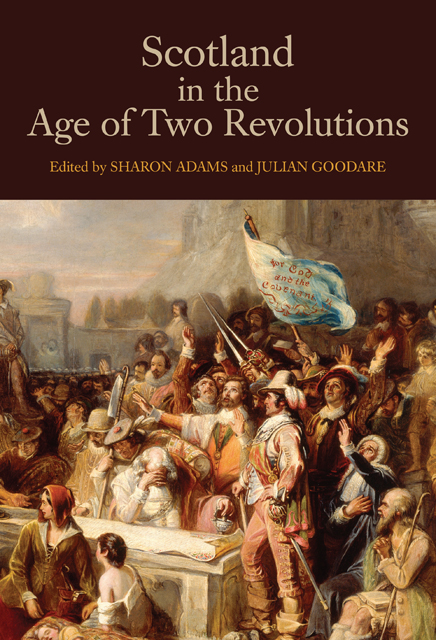Book contents
- Frontmatter
- Dedication
- Contents
- Figures and Tables
- List of Contributors
- Preface
- List of Abbreviations
- 1 Scotland and its Seventeenth-Century Revolutions
- 2 The Middle Shires Divided: Tensions at the Heart of Anglo-Scottish Union
- 3 The Western Highlands and Isles and Central Government, 1616–1645
- 4 The Scottish Bishops in Government, 1625–1638
- 5 The Scottish Revolution
- 6 In Search of the Scottish Republic
- 7 Highland Lawlessness and the Cromwellian Regime
- 8 The Worcester Veterans and the Restoration Regime in Scotland
- 9 The Political Thought of the Restoration Covenanters
- 10 Scottish State Oaths and the Revolution of 1688–1690
- 11 The Tribulations of Everyday Government in Williamite Scotland
- 12 The Company of Scotland and Scottish Politics, 1696–1701
- Chronology of Seventeenth-Century Scotland
- Further Reading
- Index
- Studies in Early Modern Cultural, Political and Social History
1 - Scotland and its Seventeenth-Century Revolutions
Published online by Cambridge University Press: 28 February 2023
- Frontmatter
- Dedication
- Contents
- Figures and Tables
- List of Contributors
- Preface
- List of Abbreviations
- 1 Scotland and its Seventeenth-Century Revolutions
- 2 The Middle Shires Divided: Tensions at the Heart of Anglo-Scottish Union
- 3 The Western Highlands and Isles and Central Government, 1616–1645
- 4 The Scottish Bishops in Government, 1625–1638
- 5 The Scottish Revolution
- 6 In Search of the Scottish Republic
- 7 Highland Lawlessness and the Cromwellian Regime
- 8 The Worcester Veterans and the Restoration Regime in Scotland
- 9 The Political Thought of the Restoration Covenanters
- 10 Scottish State Oaths and the Revolution of 1688–1690
- 11 The Tribulations of Everyday Government in Williamite Scotland
- 12 The Company of Scotland and Scottish Politics, 1696–1701
- Chronology of Seventeenth-Century Scotland
- Further Reading
- Index
- Studies in Early Modern Cultural, Political and Social History
Summary
Seventeenth-century Scotland saw two political revolutions. Along with these came intense religious strife culminating in the beginnings of toleration, and the modernisation of the state and its infrastructure. In this book we present some of the latest research on seventeenth-century Scotland, especially (though not solely) its political and religious history. In a period when political ideologies were presented so much in religious terms, it can be hard to separate the two.
I
This book is distinctive because it focuses on the history that the Scots themselves made during the seventeenth century. One of the most seductive and sometimes misleading aspects of ‘seventeenth-century Scotland’ is that it tends to be framed by two conventional dates: 1603 and 1707, the union of crowns and union of parliaments respectively. Thus Anglo-Scottish relations tend to dominate the story. The date 1603 may have additional popularity because so many works on English history also use it – but in England it mainly represents a new dynasty, rather than a new relationship with Scotland. David Stevenson, who has pointed out these problems with the 1603–1707 periodisation, adds a further problem. Because Anglo-Scottish union raises strong feelings today, it has produced a lot of biased history, concerned either to celebrate or to denigrate the Anglo-Scottish union. Here we seek to do neither.
This book, then, asks how seventeenth-century Scotland would look if we focused on things that the Scots themselves wanted and chose to do. Here the key organising dates are not 1603 and 1707 but 1638 and 1689. The covenanting revolution of 1638 transformed Scottish politics, restructuring Scotland’s constitutional, administrative, fiscal and military system, and bringing a sharper ideological edge to governmental aspirations. Much of the story of the generation before 1638 in Scotland is the story of the making of the revolution. Even more obviously, the story of the two generations after 1638 is the story of the working out of the revolution: the victories and defeats, the splits, reactions, intensifications and – eventually – the triumph in 1689 of a governmental system remarkably like that which the Covenanters sought. Although Scotland’s revolution in 1689 followed English events, it obviously had indigenous roots in Scottish grievances against James VII and II, and the revolution regime built up its own momentum that did not always follow the same course as the English one.
- Type
- Chapter
- Information
- Scotland in the Age of Two Revolutions , pp. 1 - 22Publisher: Boydell & BrewerPrint publication year: 2014

